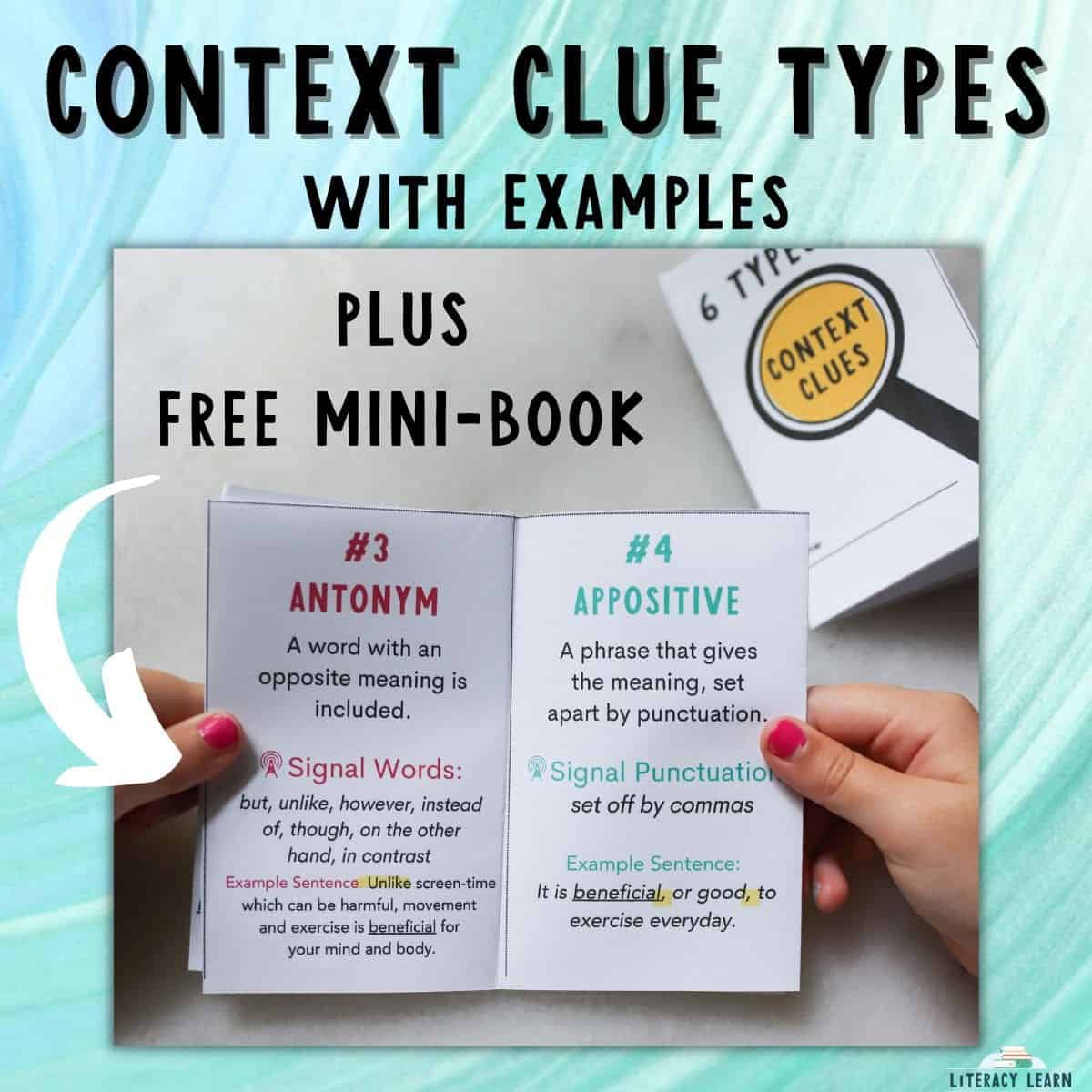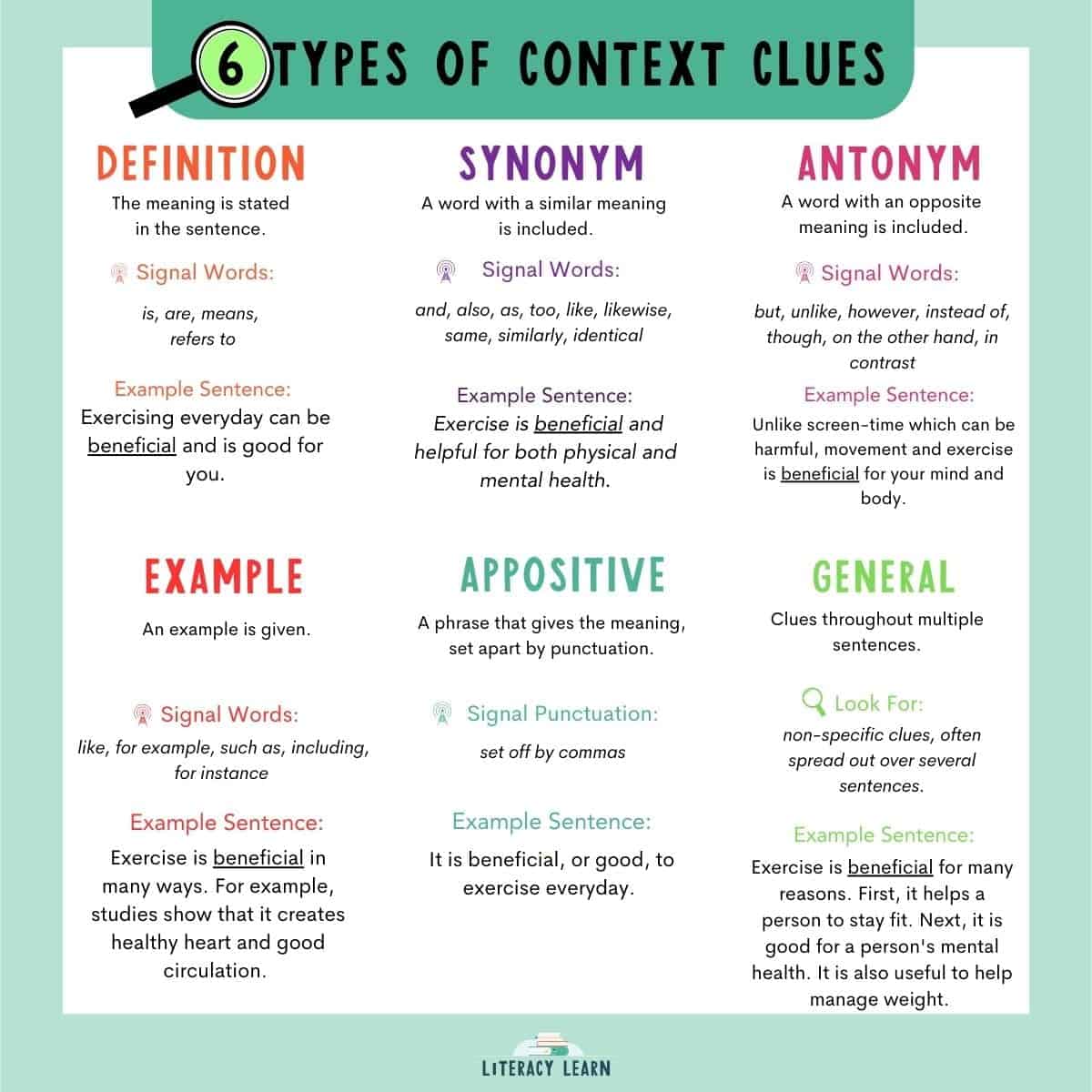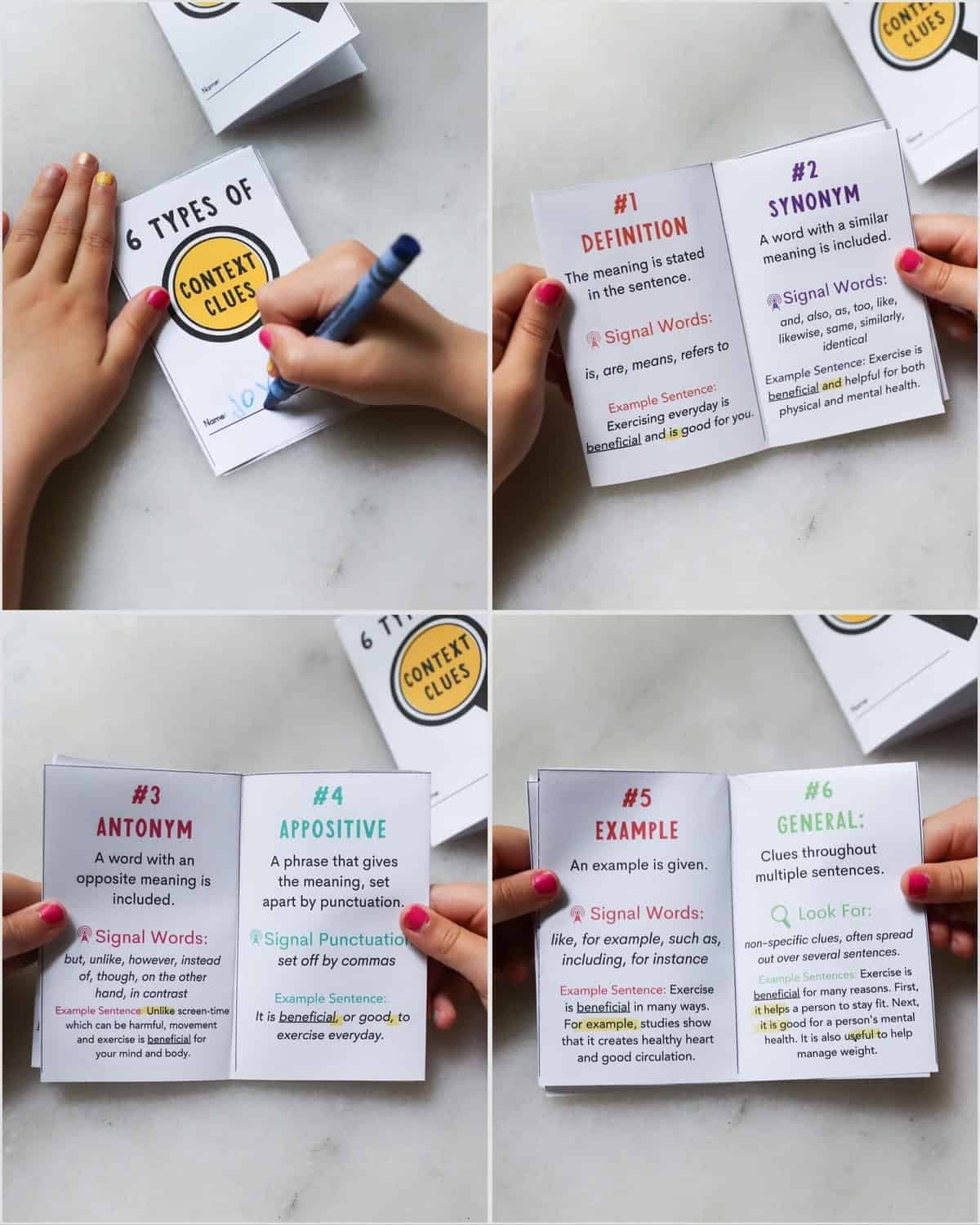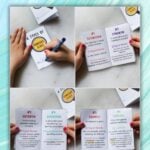6 Context Clue Types with Examples & FREE Mini-Book
This post may contain affiliate links. As an Amazon affiliate, we earn from qualifying purchases. See our disclosure policy.
Learn how to teach the 6 types of context clues with examples of each one. This is an essential strategy for understanding and learning new vocabulary! Get a fun and free mini-book that clearly shows the different types of context clues, signal words, and examples for your students to use!

What Are Context Clues?
Context clues are words around the unknown word which give hints as to the word’s meaning.
In order to understand what you’re reading, you must know word meanings. Occasionally, you’ll find a word you can decode (or read accurately) but are unsure of its meaning. Strong readers will use context clues to determine the meanings of difficult words.
🤔 Think about this word: petulantly. Have you heard this word before? Do you know what it means? If not, try reading the sentence below and try to infer what the word means using context:
The child crossed his arms, frowned, and pouted petulantly when his ice cream cone fell on the ground.
Notice how the other words within the sentence can help you figure out the meaning of petulantly? If you look closely, you’ll notice two kinds of context clues:
- Example context clue: “The child crossed his arms.”
- Synonym context clues: “frowned” and “pouted.”
The various types of context clues help you to infer the meaning of the word: “In an angry or sulky way.” You can almost visualize the child’s face; If it were an emoji, it might be this one: 😖
By explicitly teaching the 6 types of context clues, students can learn to use context to help determine the meaning of a tricky or unknown word.
This improves reading comprehension and will be an incredibly powerful tool in a child’s word-learning toolbox!
6 Types of Context Clues
According to the Vocabulary Handbook (2021), there are 6 types of context clues:
- Definition: The meaning of the word is stated in the sentence.
- Synonym: Another word with a similar meaning is stated in the sentence.
- Antonym: A word with an opposite meaning is stated in the sentence.
- Example: An example of the definition is included within the sentence.
- Appositive: The word’s meaning is included and set apart by commas.
- General: Clues are given over the course of multiple sentences.
🚦 Each type has signal words or punctuation that help the context clue types stand out.

🔍 Context Clue Types Examples
It’s super helpful to teach kids the types of context clues using examples. Below are the types and a few examples of each, with signal words or punctuation underlined.
Definition Type
- The garden had flowers growing in abundance, meaning the flowers were growing everywhere.
- Meander means to follow a winding or complicated course.
- A mesa is a flat-topped hill with steep sides.
Appositive Type
- The dog was really enormous, or gigantic, and took up the whole couch.
- Sophia had a mischievous, or playful, smile on her face when she hid behind the door and scared her brother.
- The teacher was elated, or extremely happy, when all the students aced their spelling test.
Synonym Type
- The jubilant crowd went crazy when the team won the championship game as they joyfully cheered.
- In the heat of the summer, the kids were thankful for the enormous tree. It was so big that it shaded the entire playground.
- Sarah’s impeccable manners impressed everyone at the dinner party. Her sister, Clara, had flawless manners, too.
Antonym Type
- The weather was scorching hot, but the pool water was refreshingly cool.
- Jeremy’s room was a chaotic mess, unlike his sister’s room which was neat and organized.
- The movie’s beginning was very dull; however, as it went on, it became exciting and action-packed.
Example Type
- The farmer planted different crops, such as corn, beans, and potatoes.
- The zoo had an exhibit with large canines, including wolves, wild dogs, and coyotes.
- My sister has a variety of pets. For example, a dog, a cat, two rats, a bunny, a horse, a snake, and a goldfish.
General Type
- The children galivanted around in the first snowfall of the season. They spent hours building snowmen, having snowball fights, making snow angels, and enjoying the winter weather.
- My dad’s business was going through a merger. Dad said he was joining forces with another business and they would work together from now on. He was excited about the new team he would be working with.
- The sweet aroma of freshly baked bread, cookies, and cakes filled the air at the bakery. Mom and I couldn’t help but buy a box full of bakery treats after taking a sniff.
👨🏽🏫 How to Teach Word-Learning Strategies
It’s going to be very important to teach kids explicitly about context clues as outlined above. But it is also imperative to teach them to use morphemic (word part) analysis. This is looking for word part clues within the unfamiliar words. Kids should ask themselves:
- Does it have a prefix?
- Does it have a suffix?
- What is the meaning of the base word?
- Does it have a Greek or Latin root?
You also want to make sure your students know how to use a dictionary. More importantly, that they know how to use what they find in a dictionary in a meaningful way!
Research from the National Reading Panel has shown that these three instructional strategies, when used together, are most effective to help kids discover word meaning.
As children get older and read more complex texts, they will continue to see unknown words and will need to use context clues, morphemic analysis, and dictionaries to learn new vocabulary.
✨ So, the best way to teach these word-learning strategies is to explicitly teach them! That’s why we created our context clue resources, to help make your teaching easy and effective. When teaching context clues, teach clues one at a time, and give kids opportunities to practice.
👍🏼 If you don’t know much about morphemic analysis, I’d highly recommend IMSE’s Morphology course. I took it and learned a ton! You can read more about this in this post on the best OG trainings.

The Mini-Book
We’re providing you with a FREE context clue mini-book that you can print and use with your students. Download the color OR black and white version below!
📖 This mini-book is PERFECT for kids to use when reading!
🔖 They can keep it close and use it as a bookmark when reading on their own.
💛 Students love putting the book together (you may see them start to make other books following this method too). You can show our video for step-by-step instructions on how to make the mini-book.
It also pairs perfectly with our Context Clue Anchor Chart. You can print the anchor chart, hang it up, and now your students have multiple resources to help them learn the meanings of new words.
Related Posts
Download & Print
We’d love to hear about your experience using these resources!
Please leave a comment below or tag us on Instagram @literacylearn!
DOWNLOAD TERMS: All of our resources and printables are designed for personal use only in homes and classrooms. Each teacher must download his or her own copy. Please do not save to a shared drive, reproduce our resources on the web, or make photocopies for anyone besides your own students. To share with others, please use the social share links provided or distribute the link to the blog post so others can download their own copies. Your support in this allows us to keep making free resources for everyone! Please see our Creative Credits page for information about the licensed clipart we use. If you have any questions or concerns regarding our terms, please email us. Thank you!

